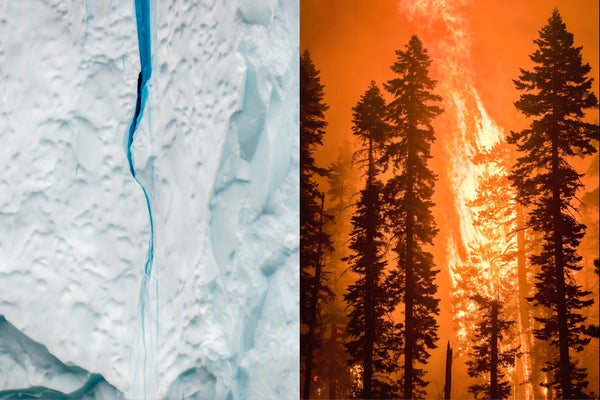Emily Schwing: This is Scientific American’s 60 Second Science. I’m Emily Schwing.
Oil and water. Apples and oranges. Fire and Ice…none of these things really seem like they have much to do with one another…or do they?
Hailong Wang: We found that more fire-favorable weather associated with declines in the Arctic sea ice during summer can increase autumn wildfires over the western United States.
On supporting science journalism
If you're enjoying this article, consider supporting our award-winning journalism by subscribing. By purchasing a subscription you are helping to ensure the future of impactful stories about the discoveries and ideas shaping our world today.
Schwing: Hailong Wang is an Earth scientist at the Pacific Northwest National Laboratory in Washington state.
Wang: So we analyzed a few decades of observations of how wildfire incidents, sea ice cover and weather conditions to identify a relationship between Arctic sea ice decline and the wildfire risks. We called it a teleconnection.
Schwing: Wang says this idea of a fire and ice “tele-connection?” … It’s not new. It’s a lot like the so-called “butterfly effect” - a term coined by meteorologist Edward Lorenz in the 1960’s to explain chaos theory. The idea can be summarized like this: if a butterfly flaps its wings in one location, that could displace enough air to cause a tornado or some other large scale atmospheric storm elsewhere.
Wang: Certainly didn't invent this concept, but it has been in the atmospheric sciences for a long time. So, because of the connections within the Earth system, especially in the atmosphere, one small change in one region could affect other regions through the atmospheric circulations.
Schwing: Connections between declining sea ice and wildfire weather have been made before. Wang says previous findings have relied heavily on statistical relationships.
Wang: For example, they find that they found that maybe Arctic sea ice are declining in many years, and they also found the increase in extreme weather like wildfires in the western U.S. They can only identify the relationship, but there's no mechanism to explain which which one is the cause? Which one is the effect?
Schwing: [possible VO:
Those relationships found a link between a decrease in sea ice and an increase in wildfires in the WEstern US, but they could not explain the cause and effect. ]
So Wang and colleagues took those known statistical relationships a step further. The team applied them to a state of the art climate model with wildfire prediction capabilities.
Wang: In that way, we were able to identify the response of the climate system, including the fire weather over the western U.S. and other responses to the Arctic sea ice.
Schwing: What they found is “a tale of two vortices.”
Wang: So when the summer sea ice is much reduced, ocean can absorb and store more heat from sunlight. Less sea ice cover over the Arctic will allow more heat to be also to be released from the ocean to the atmosphere in the following autumn and early winter. Otherwise, the sea ice can insulate the heat from the ocean to the air.
Schwing: So, more heat is released to the atmosphere as the sea ice declines.
Wang: The anomalous heat in the Arctic can form rising air from the surface, and that can strengthen the low pressure system, which is one of the the spinning vortex. It’s counter-clockwise.
Schwing: This forms a low pressure system and Wang says when it moves south, it pushes the polar jet stream off its normal course and forms a second vortex.
Wang: So this shift also facilitate[s] the formation of a high pressure system over the western U.S. This high-pressure system is a clockwise spinning vortex. This drives dry and hot hot air to descend to the ground—from the upper air to the ground. Normally it comes with clear skies and no precipitation. So those are all favorable weather conditions for wildfire hazards.
Schwing: The findings are published in Nature Communications. And Wang says wildfire might not be the only result of declining sea ice. [Yufei Zou et al., Increasing large wildfires over the western United States linked to diminishing sea ice in the Arctic]
Wang: The arctic changes could also be connected to extreme cold weather.
Schwing: Like the infamous 2021 Texas ice and snow storm that knocked out power to millions and caused billions of dollars in damage. Wang says looking for more “teleconnections’ is where his research will go next.
Wang: Moving forward, we would like to explore more connections of Arctic changes to weather, extreme weather, climate change over other regions of the entire globe.
Schwing: If wildfires and sea ice could be this climatically entwined, surely there are other climate surprises just waiting to be unraveled.
For 60 Second Science, I’m Emily Schwing.
[The above text is a transcript of this podcast.]

